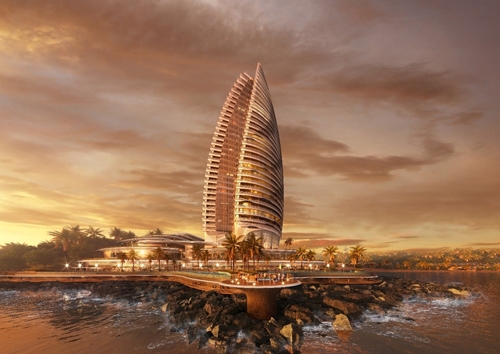Transformation of once-untouched island
In the Southwestern waters of Vietnam, Phu Quoc island has undergone a metamorphosis over the recent past.
A decade ago, the sparsely – populated island with rudimentary infrastructure attracted merely 910,000 tourists, few of them from abroad. The transport infrastructure was poor, featuring a single 50-kilometer road running from North to South - a journey that took four to five hours.
    |
 |
|
Perspective view of Aspira Tower – set to become the next iconic landmark of Phu Quoc (Photo: Sun Group) |
Nguyen Kim Ngoc, a local in residential area No.5, Duong Dong ward, said in the past inhabitants relied on diesel generators for electricity while the local economy was primarily sustained by pepper cultivation, fishing, and traditional fish sauce making. There were no urban areas as well as high-end resorts and theme parks like today.
In 2014, Phu Quoc island district achieved the tier-2 urban area status, and it was elevated to a city in 2021 and then a tier-1 urban area of Kien Giang province in early 2025. In just a decade, the island has developed international airports and seaports and been connected with the national power grid with the longest undersea cable in Southeast Asia.
Chairman of the provincial People’s Committee Nguyen Thanh Nhan said that after more than two decades carrying out the master plan on Phu Quoc island development under a decision issued by the Prime Minister, Phu Quoc has positioned itself as one of the country’s 30 tier-1 urban areas and among the only four in the Mekong Delta. With its potential and solid foundation, Phu Quoc is gearing towards a green and smart urban area, becoming a regional and international centre of services, high-quality ecotourism, and sea and island tourism that is able to connect with economic hubs in the region and the world under the Politburo’s Resolution No.13.
A dynamic gem
Phu Quoc has become a magnet for major investments, particularly in transport, urban, environment and tourism infrastructure. Sun Group and Vingroup have played pivotal roles in this transformation.
In the South, Sun Group has invested in a comprehensive ecosystem spanning tourism, entertainment, and high-end real estate. In 2016, the JW Marriott Phu Quoc Emerald Bay resort put the island on the international tourism map. Two years later, the world's longest sea-crossing three-wire cable car system was established, offering visitors breathtaking views of the pearl island.
The group has developed a comprehensive ecosystem with investments totaling tens of thousands of billions of VND. Within 2023-2024, it unveiled a series of projects that have attracted throngs of both domestic and international tourists, including the Sunset Town, the Kiss Bridge, and artistic firework shows. Construction is underway for an international hospital and a seaside square at Dat Do Beach, designed to enhance amenities for both local residents and tourists. A standout project is the Aspira Tower at Hon Thom, which is set to become the world's second sail-shaped tower, further elevating Phu Quoc's global brand recognition.
In the North, Vingroup laid ground for the island to become a tourism magnet. In 2014, it launched the Vinpearl Phu Quoc complex, featuring luxury hotels, villas, an international 18-hole golf course, and a modern entertainment park. In 2021, it introduced the Phu Quoc United Center, an international-standard super complex offering comprehensive experiences from accommodation to entertainment.
With the “all in one destination” model, the complex has been renowned internationally with its iconic facilities like VinWonders Phu Quoc – the largest theme park in Vietnam with a top-five global aquarium, Vinpearl Safari Phu Quoc that sets world record for conserving the world’s largest number of individual animals of diverse species, Grand World - Vietnam's first-ever “sleepless city”, Teddy Bear Museum, and the Quintessence of Vietnam Phu Quoc show.
Phu Quoc has transformed itself from a primarily maritime economy to a critical tourism and economic centre. The island now makes significant contributions to the development of Kien Giang province, the Mekong Delta region, and Vietnam as a whole.
Chairman of the Phu Quoc city People’s Committee Tran Minh Khoa said the island’s economy has consistently maintained high growth rates, with production value increasing by over 38% annually between 2011 and 2024. Tourism has been the primary driver of the growth, with visitor number surging to 5.9 million in 2024. This year, Phu Quoc eyes to welcome 7 million tourist arrivals, including one million foreigners.
Besides, the island has become an investment magnet, attracting 321 projects with a total investment of 428 trillion VND (16.7 billion USD), or 45.8% of the province's total. The harmonious development of socio-economic infrastructure has been crucial, with the international airport now providing direct connections to major domestic and international cities.
Phu Quoc has been selected to host the 2027 APEC Economic Leaders' Week – a catalyst for the island city’s development, affirming its position in the international arena.
Nhan stressed that the APEC 2027 event represents an invaluable opportunity for the island's robust growth in the new era – that of the nation’s rise.
After 50 years of national reunification, Phu Quoc stands at the threshold of new opportunities to become the premier coastal city in Vietnam and the region. The upcoming APEC 2027 event represents a watershed moment as it will be not only the occasion for Vietnam to assert its international standing but also a chance for Phu Quoc to accelerate its development, generate investment momentum, propel tourism, and promote its image as a world-leading tourism paradise.
Source: VNA